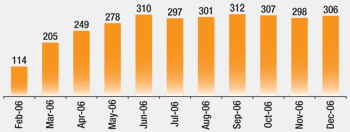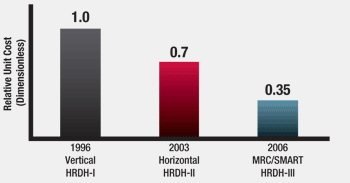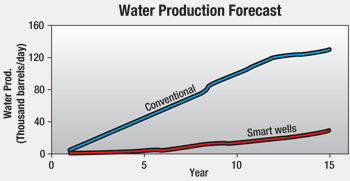By any measure, Saudi Arabia’s Ghawar, the world’s largest oil field with roughly 5 million barrels of daily output, holds an unparalleled significance to the future of global oil supplies. The Haradh area constitutes the southernmost portion of the giant Ghawar complex, and what makes Haradh uniquely interesting is its role as a launching pad for a new era in reservoir management – technology-intensive, smart, and real-time.
Against a backdrop of many international upstream projects straining to achieve their target production levels and intended plateaus, Haradh III reached its planned production capacity of 300,000 barrels per day well ahead of schedule, and the field’s performance more than 18 months since its start-up exceeds virtually all pre-project goals.
What Makes Reservoirs Tick?
While the ongoing debate regarding global oil supplies shows no signs of abating, the underlying challenges facing the industry are relatively straightforward: reduce unit development and operating costs, and increase production and reserves.
One might argue that success in fulfilling these goals – at least within the sub-surface domain – depends on a limited though well understood number of factors: (1) geological attributes; (2) reservoir management tenets (i.e., collection of best practices and principles); (3) technology; (4) price; and (5) external issues (geo-political, environmental, logistical, etc.). From a practical perspective, only two of the above factors, tenets and technology, offer decision-makers the opportunity to exert their influence. Thus, Haradh III provides a good case study for understanding what in modern reservoir management differentiates successful projects from unsuccessful ones.
Three questions (or the 3Qs) determine the fate of most reservoir development projects.
1. Do you have the insight? Are the reservoir fundamentals understood?
2. Can you verify the validity of the insight?
3. And most important, do
you have the capability, resources, and organizational will to execute plans
derived from and required by the insight?
As simple as these 3Qs are, the correct answers remain elusive for many underperforming fields worldwide.

Haradh-III crude oil production ramp-up in
thousand
barrels per day.
Haradh Development: A Brief Overview
The Haradh III project, encompassing the southern third portion of Haradh, came on-stream in February 2006, adding 300,000 bpd of Arabian light crude production capacity to Ghawar. The project took 21 months, and entailed construction of a grassroots surface-facility network, integrated with a complex sub-surface development program. Maximum Reservoir Contact (MRC) wells, smart completions, geo-steering, and the latest information technologies were part of Haradh III, at a scale and complexity unprecedented for Saudi Aramco and arguably, for the global upstream industry. A decade from now, these will likely become standard in the lexicon of mega projects, providing much-needed supplies to the world markets.

MRC wells are standard features of the subsurface
architecture in Haradh-III.
From a technology-impact perspective, Haradh is interesting because the field was developed in three phases over a decade. Initial production from Haradh I occurred in May 1996, followed up by Haradh II in April 2003 and Haradh III in February 2006. Haradh I was developed exclusively with vertical wells. Haradh II relied on single-horizontal producers and injectors. Haradh III brought together a four-component technology menu relying on geo-steering, MRC wells, smart flow-controls, and strong information technology systems. The total Haradh production capacity is 900,000 bpd, with equal contributions from the three sub-segments and with progressively more complex sub-surface technologies. Arab-D, the main producing horizon for the giant Ghawar complex, is characterized in the Haradh area by distinct geological features – faults, fractures, and fracture swarms – which, in combination with the fast-track (30-month) project schedule, posed serious challenges in the planning and execution stages and offered the ultimate test to the new technologies.
The field was planned to be supported by peripheral water-injection, which preceded the crude production by four months, as part of the planned pressure maintenance program.
The Technology Factor: How It Lifted the Project
Haradh III became the first Saudi Aramco project to be developed exclusively with MRC wells, with down-hole ICVs for flow control. Average well-production rates were targeted to be 10,000 bpd (which was achieved), compared with 3,000 bpd for Haradh I and 6,000 bpd for Haradh II.
The smart completions were necessary to ensure production sustainability against the risk of premature water encroachment through fault and fracture systems. The well requirements and relative unit costs would have been considerably higher had vertical or conventional single-horizontal wells been selected for Haradh III instead of MRC wells.
Geo-steering played a major role in Haradh III because accurate placement of multi-laterals within the Arab-D reservoir as well as the integrity of hole trajectories were necessary to achieve desired target rates of 10,000 bpd.
The fourth technology component in Haradh III was I-field. All 12 of the observation and 28 of the MRC-well completions were equipped with a Permanent Down-Hole Monitoring System (PDHMS). The sub-surface data was transmitted in real-time to Dhahran (roughly 350 kilometers from Haradh) and complemented real-time surface measurements fed through the supervisory-control and data-acquisition (SCADA) system.
The onset of peripheral injection in November 2005 allowed real-time generation of field-wide isobaric maps, which in turn produced an instantaneous and improved understanding of the reservoir geology – most notably, such features as fault/fracture systems and intra-reservoir connectivity. Arguably this event, however modest in scope, may mark the beginning of the real-time reservoir management era for Saudi Aramco. The real-time isobaric maps defused pre-project concerns about efficacy of peripheral injection. Even more importantly, areas prone to water encroachment were quickly identified, preventing loss of oil production in the northwest corner of Haradh III. The project’s production/injection start-up was smooth and its quick build-up enabled it to meet target production ahead of schedule.

Relative unit well costs show impact of
technologies
over a decade. Note: Costs are
relative in cost per bbl/day.
Upstream Technologies: The Emerging Trends
It would be an overstatement to suggest that any single project can define the new face and personality of the upstream sub-surface. Yet, certain unmistakable features of the new age are emerging and can be recognized in Haradh III: complex well architectures; higher-intelligence ICVs and the capability to control reservoir flow through them; real-time access to information; and precise imaging and sophistication in computer modeling of increasingly complex well-reservoir systems. The huge gains in well productivity and reduction of unit costs, as exemplified by Haradh III, are partly due to the rapid penetration of the computer chip into the realm of the sub-surface during the last decade.
The word “partly†must be used here, since the Haradh III’s success is inseparable from Saudi Aramco’s best practices in reservoir management tenets. Without them, technology would be a tool for achieving faster results, but not necessarily those superior in content (i.e., production targets or long-term recoveries). As noted above, the 3Qs set the right framework for success. Recognition of correct priorities among various project aspects, such as financial, drilling, production, facilities, operational, and reservoir, is a necessary pre-condition. In the case of Haradh III, the ultimate decision-making rested with reservoir management – a key to its success.

Smart wells do make a difference. Simulation
results
predict more than a two-fold
in water production over a 15-year period
as a
result of smart wells.
Looking Ahead
Haradh III’s most distinctive aspect as an engineering undertaking is its role as a platform for bringing together three new technologies: geo-steering, MRC wells, smart controls, and I-field. The resulting synergy was clearly larger than the sum of its parts. A project that had all the markings of a complicated, risk-prone development endeavor under conventional oil-field paradigms (vertical wells, no ICVs, sparse, fragmented, and delayed data transmission), surpassed expectations under a boldly different approach. The principal sub-surface challenges and their pre-project risks (premature water breakthrough, loss of oil production, high-decline rates) were for the most part managed. Eighteen months after initial production on January 31, 2006, the field is maintaining its production capacity at 300,000 bpd, at virtually no water production, and with 100 percent active status for all its initial producers. This stellar performance report is not to suggest the field will be devoid of unanticipated challenges in the future. The point is that modern reservoir management technologies, when applied with due diligence, matter a lot.
The lessons from Haradh III for other projects are neither straightforward nor obvious. As the German philosopher Goethe remarked over a century ago, “Imitation comes natural to us, but it is not always obvious what to imitate.†Every upstream project fails or succeeds as a result of its own set of realities and its performance vis-à -vis the 3Qs. Haradh III showed one way to the future. The future must now define itself on a case-by-case basis. .
Nansen Saleri, the former head of reservoir management for Saudi Aramco, is now the president of Quantum Reservoir Impact.
© 2004-2013 Green Car Congress